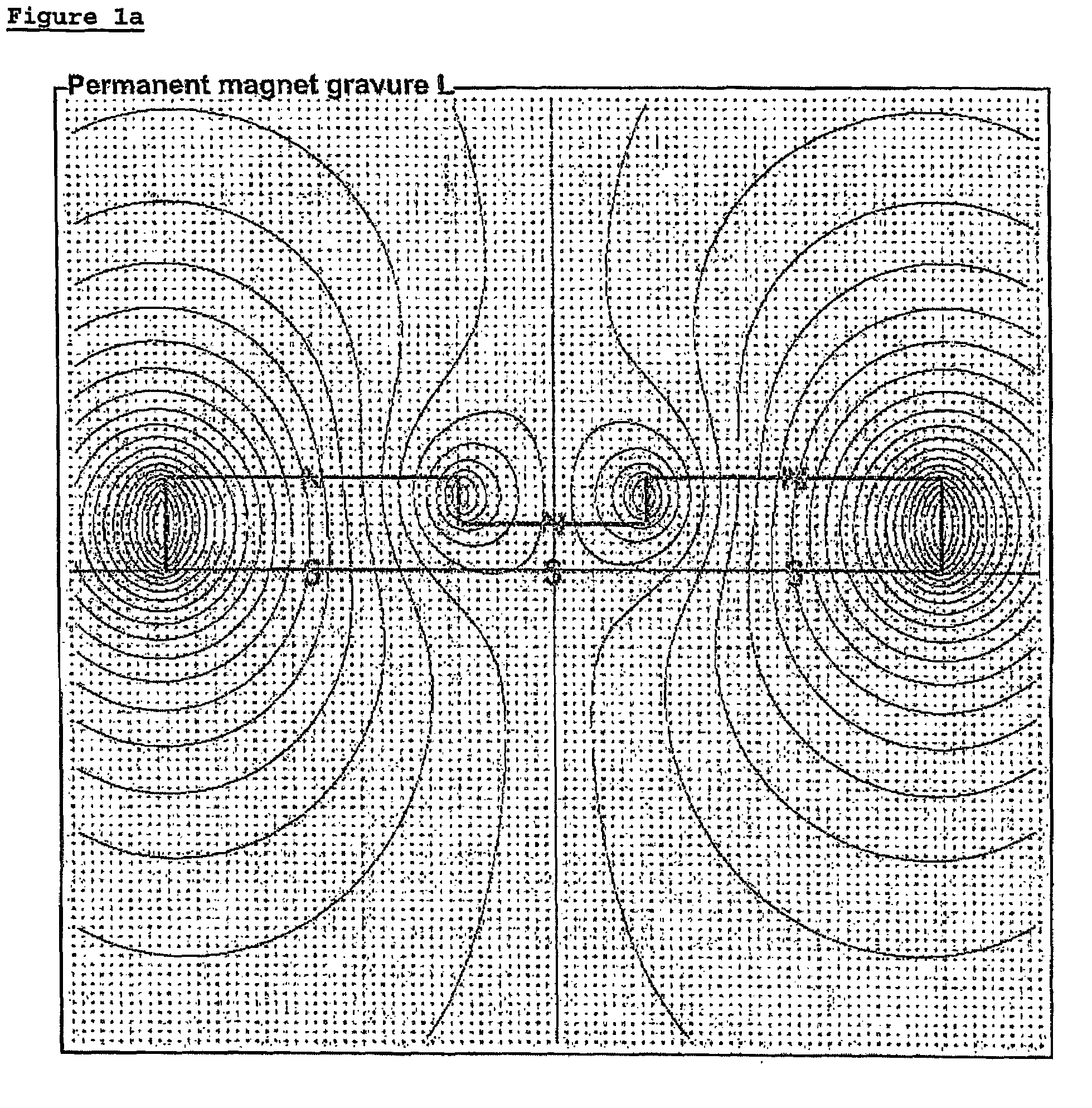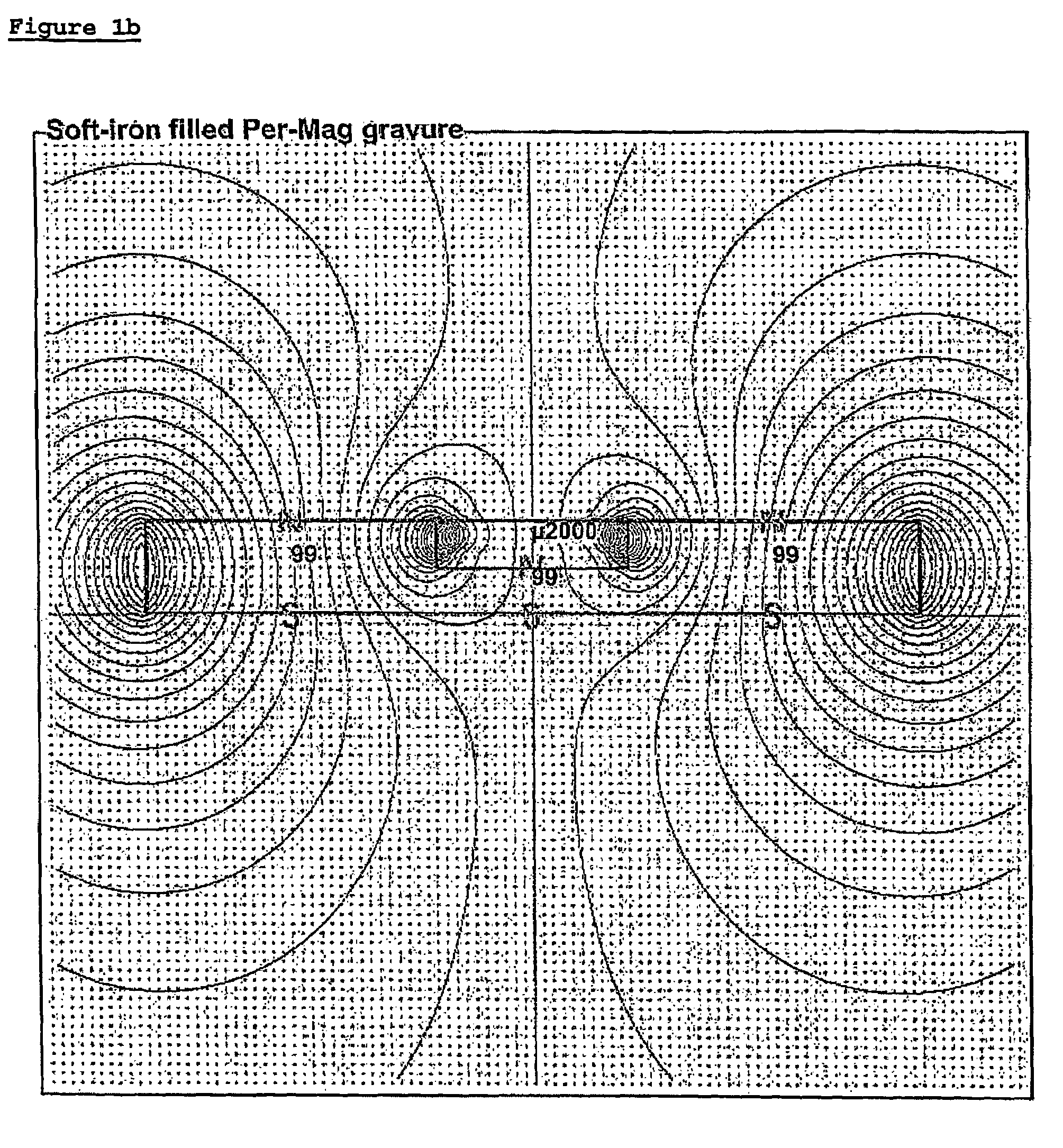Method and means for producing a magnetically induced design in a coating containing magnetic particles
a technology of magnetic particles and coatings, applied in the field of security document printing, can solve the problems of inability to combine optically variable and magnetic properties in the same pigment, the cost of optically variable pigments is more expensive in manufacturing, and the composition of optically variable pigments is not feasibl
- Summary
- Abstract
- Description
- Claims
- Application Information
AI Technical Summary
Benefits of technology
Problems solved by technology
Method used
Image
Examples
example 1
[0069]A Plastoferrite plate, magnetised in a direction perpendicular to the surface (model M100.8, Maurer magnetics AG, CH-8627 Grüningen), was engraved on a computer-controlled mechanical engraving station with text of different sizes (see FIG. 2a). The characteristics of these engraving were as follows:[0070]Text height and width: form 3 to 7 mm[0071]Depth of engraving: 150 μm for the smallest characters, up to 250 μm for the largest[0072]Line width: from 200 μm for the smallest characters to 800 μm for the largest
[0073]An OVI® silkscreen ink of the following formula, comprising a magnetic optically variable pigment, was prepared:
[0074]
Diethyl ketone23%Ethyl diglycol29%Solution Vinyl VMCA (Union Carbide)22%BYK-053 (BYK) 1%Magnetic Optically Variable Pigment*25%*magenta-to-green, 7 layers design as disclosed in WO 02 / 73250: Cr / MgF2 / Al / Fe—Ni / Al / MgF2Cr. The Fe—Ni alloy was 85% Fe / 15% Ni.
[0075]The vinyl resin was dissolved in the ketone-glycol solvent prior to the incorporation of the...
example 2
[0078]A Plastoferrite plate (model M201.1, Maurer magnetics AG, CH-8627 Grüningen) was magnetised in a direction perpendicular to the surface and then engraved on a computer-controlled mechanical engraving station with a geometrical design (two pyramids; see FIG. 3a). The characteristics of the engraving were as follows:
[0079]
Height and width:1.5 × 2.4cmDepth of engraving:200μmLine width:200μm
[0080]The engraving corresponding to the upper pyramid was filled up with a polymer, so as to result in an even surface of the engraved plate; the engraving corresponding to the lower pyramid was left as such.
[0081]An OVI® flexography ink comprising a magnetic optically variable pigment of the following formula was prepared:
[0082]
Neocryl BT-105 (Avecia)41.5% Deionised water 18%Dowanol DPM (Dow) 6%AMP-95 ™ (Angus Chemie GmbH)1.5%Neocryl BT-100 7%Tego Foamex 800 (Tego Chemie Service GmbH)0.5%Aerosil 200 (Degussa)0.5%Magnetic Optically Variable Pigment* 25%*green-to-blue, 5 layers design, Cr / MgF...
example 3
[0086]A Plasto-ferrite plate as used in example 1 was engraved on a computer-controlled mechanical engraving station with text (see FIG. 4a). The characteristics of the engraving were as follows:
[0087]
Text height and width:7mmDepth of engraving:250μmLine width:300μm
[0088]An UV drying soft-magnetic screen ink without optically variable properties was prepared according to the following formula and known procedures:
[0089]
Epoxyacrylate oligomer37.5% Trimethylolpropane triacrylate monomer14% Tripropyleneglycol diacrylate monomer14% Genorad 16 (Rahn)1%Fine iron powder25% Aerosil 200 (Degussa-Heuls)1%Irgacure 500 (CIBA)6%Genocure EPD (Rahn)2%
[0090]A patch of the ink was screen-printed on a white PVC support (100 g / m2) and the imprinted support was processed as described in example 1, except that the ink was dried in situ using an UV-radiation curing unit.
[0091]FIG. 4b shows that again, the design engraved in the plate has been transferred to the soft-magnetic ink patch; the latter shows ...
PUM
| Property | Measurement | Unit |
|---|---|---|
| thickness | aaaaa | aaaaa |
| width | aaaaa | aaaaa |
| Depth | aaaaa | aaaaa |
Abstract
Description
Claims
Application Information
 Login to View More
Login to View More - R&D
- Intellectual Property
- Life Sciences
- Materials
- Tech Scout
- Unparalleled Data Quality
- Higher Quality Content
- 60% Fewer Hallucinations
Browse by: Latest US Patents, China's latest patents, Technical Efficacy Thesaurus, Application Domain, Technology Topic, Popular Technical Reports.
© 2025 PatSnap. All rights reserved.Legal|Privacy policy|Modern Slavery Act Transparency Statement|Sitemap|About US| Contact US: help@patsnap.com



